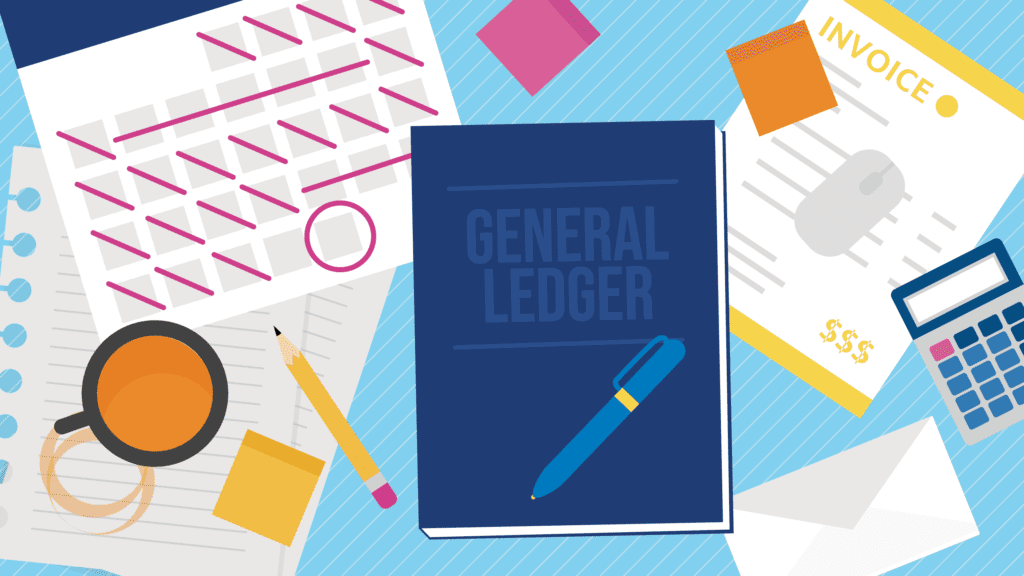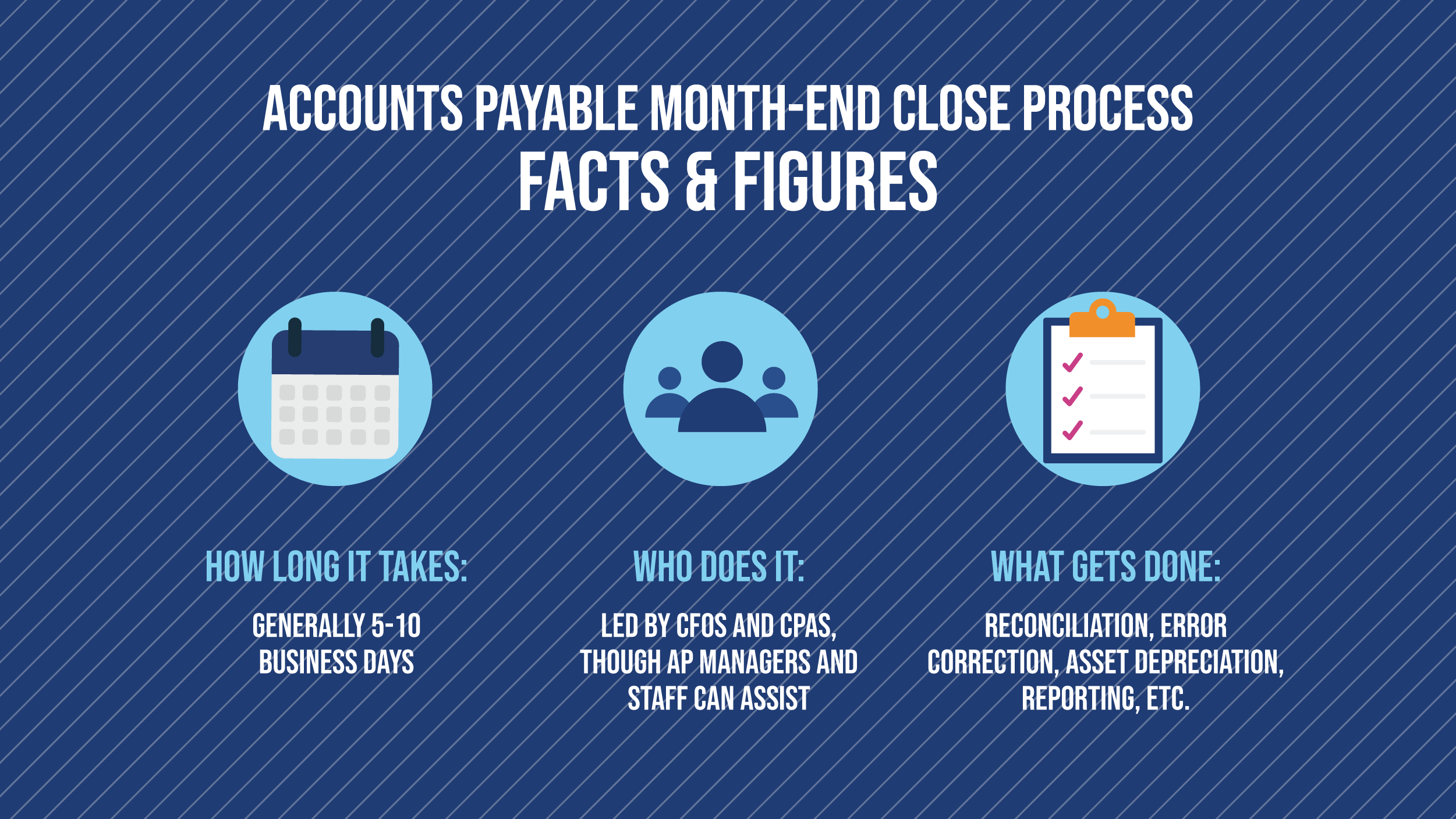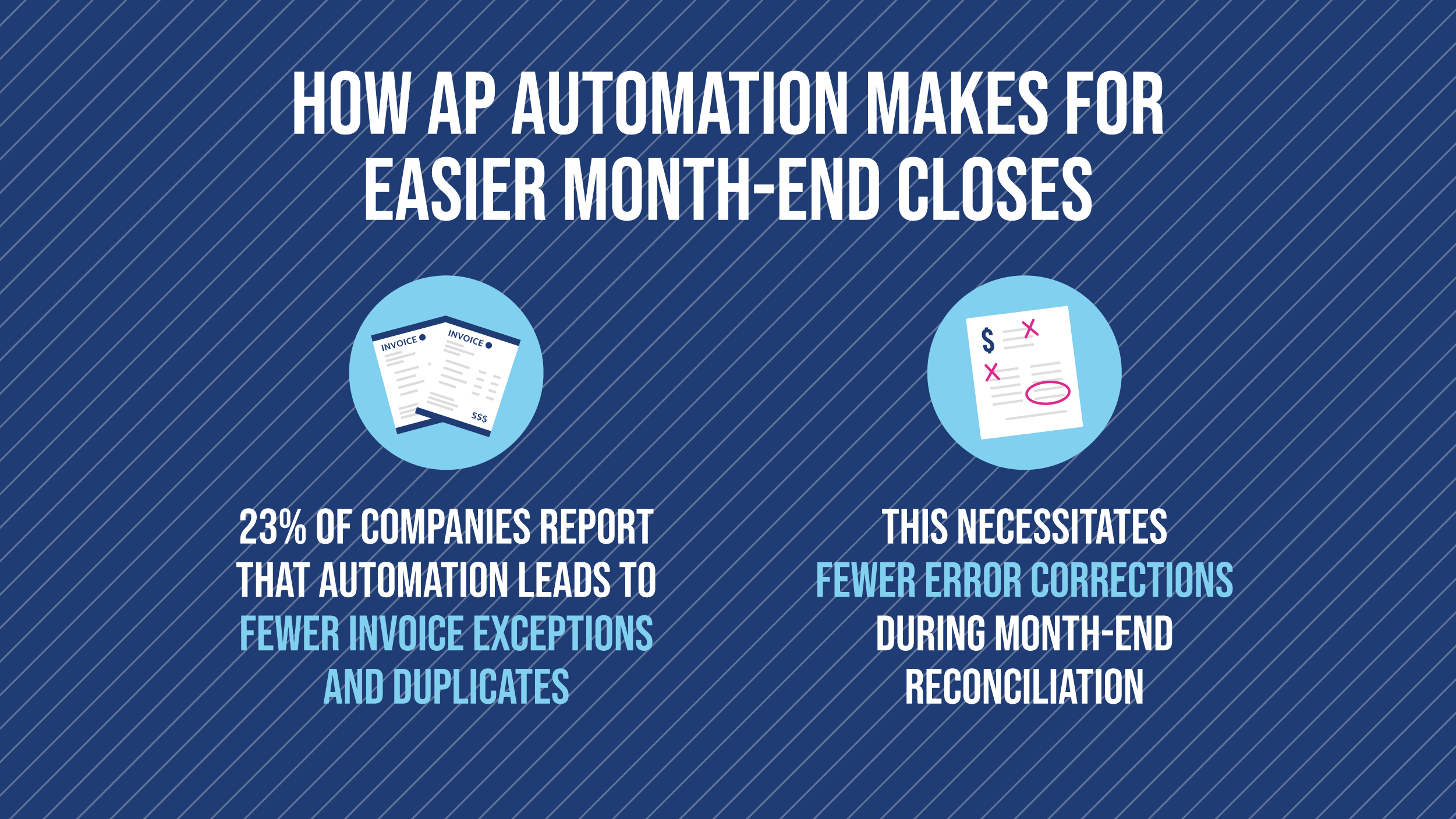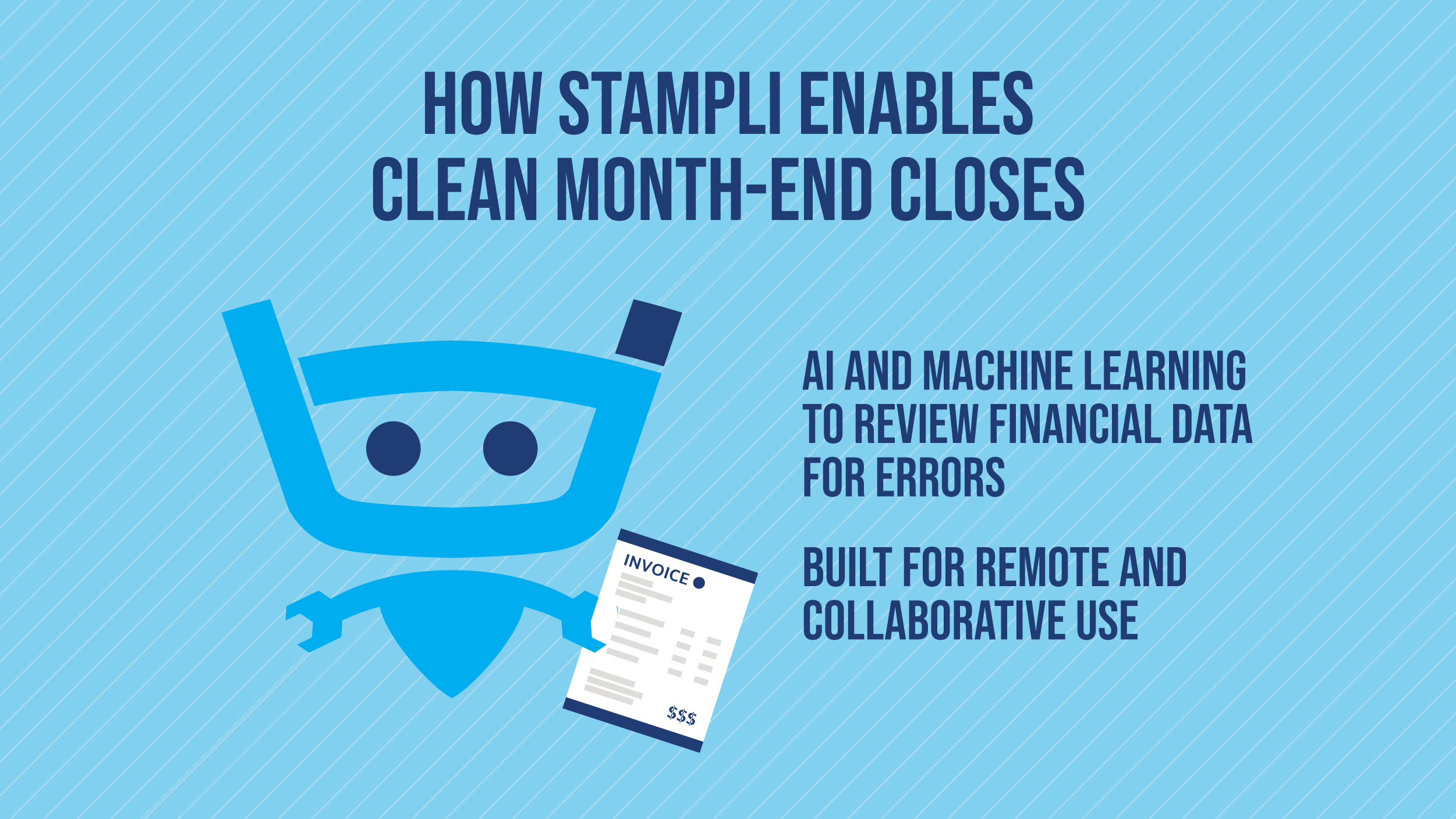Supercharge AP Month-End Close Process for Efficiency

The accounts payable month-end close process is essential for many companies, allowing them to reconcile account balances while fixing errors and producing reports for management.
But month-end can also bog AP operations down for a day or two each cycle if companies don’t have a smart process in place. In particular, businesses might be suffering unnecessarily if they’re still doing a lot of their month-end process by hand and not letting software do the heavy lifting.
Today, we’re going to explore what the accounts payable month-end close process is and look at ways to optimize it. Chief among these methods: Implementing an AP automation platform that includes month-end capabilities.
Accounts Payable Month-End Close Process Basics
First, let’s explore a few basics of the accounts payable month-end close process.

Why AP Departments Do Month-End Closes
AP departments exist to, among other things, pay bills for current periods and do so in ways that allow companies to optimize their cashflow. It’s often a few people performing this vitally important work, with a 2021 report by Stampli and Treasury Webinars, “AP Today: Bottlenecks, Benchmarks & Best Practices” finding that 47% of companies surveyed had anywhere from 1-5 full-time AP employees. Some small businesses might not have any.
Stretched thin and working hard, AP departments need to know their balance sheets are accurate, at least by the end of the month. Otherwise, companies can wind up making payments with money they don’t really have, missing discounts, and racking up late fees.
The accounts payable month-end close process is a valuable safeguard that can help companies confidently pay their bills. By performing month-end, companies can ensure the accuracy of their balances, make corrections and adjustments where necessary, and deliver reports to help with spend management, among other benefits.
Steps of the Accounts Payable Month-End Close Process
A lot can occur in a month-end close, from employees submitting documentation affirming their purchases to making note of asset depreciation and much more. Primarily, though, the accounts payable month-end close process is about balancing the books. While month-end can happen any number of different ways and accounting methods, it often includes the following for each accounting period:
- Totaling income and debits in a set period, such as the most current month;
- Reviewing balance sheet accounts, including the petty cash fund, prepaid balances, and accounts receivable;
- Correcting errors in your ERP, accounting system, or general ledger;
- Updating inventory counts, amortization calendars, or payment amounts for fixed assets, liabilities, or to lenders;
- Checking for accruals, which note transactions ahead of payments or other discrepancies;
- Also checking journal entries and adjusting entries where necessary;
- Reconciling financial statements with bank statements and account balances;
- Totaling up income statements and loss statements;
- Setting a trial balance ahead of final numbers;
- Creating reports for the preceding month or reconciliation period for senior management such as CFOs to review.
Speaking of the term month-end, by the way, it’s perfectly reasonable for companies to do reconciliations for much shorter periods (and certainly not have to wait for a year-end close.) Basically, it’s whatever amount of time a company deems necessary to review its books to make sure numbers between different sets are accurate. One of the best things with AP automation software, as we’ll explore in a bit, is that it can do daily reconciliations, giving companies virtually up to the minute data.
Strategies to Speed the Accounts Payable Month-End Close Process
Suffice it to say, month-end can be time-consuming for accounting departments, with CFO.com noting that in a survey of 2,300 companies, the median time to close the books was 6.4 days. High-performing companies could do it in 4.8 days, while low-performing companies needed as long as 10 days. But there are certainly strategies that can speed the process up.
Some of it comes down to process improvements, such as documenting best practices, workflows, and closing procedures for month-end and reconciliation, so that staff doesn’t have to reinvent the wheel, so to speak, each time month-end rolls around. It’s also important to remember to train each AP staffer on how to do month-end. Too often, companies can expect AP personnel to learn month-end on the fly. Creating a month-end close checklist can be useful, too.
There’s also something to be said for creating timelines for each month-end, particularly for company personnel to submit documentation for their expense accounts and purchase orders. A lack of this or phantom purchases can easily delay the accounts payable month-end close process and make bank reconciliation particularly tricky.
That said, perhaps the best strategy for speeding up month-end is using software that can rapidly accelerate the process.
3 Reasons to Use Software for Your Account Payable Month-End Close Process
With all the good things that the monthly closing process can pave the way for, it would seem like companies would be eager to have their accounting teams do it. Still, month-end can be a pain, partly because of how it’s often performed.
A 2021 Stampli and Treasury Webinars report, “Drivers of AP Success: Metrics, Collaboration, Influence” looked at how companies were calculating AP metrics. It found 35% did so manually in Excel, 33% did so with an ERP (enterprise resource planning) module, and 32% were using AP automation. This suggests at least 35% of companies are doing their accounts payable month-end close process manually. It’s also possible some of the companies with ERP and/or AP automation systems aren’t aware these systems can help with month-end.
While there’s no shame in companies having done month-end manually to this point, it’s advantageous for them to look to accounting software such as AP automation to help with the process. It can make it go much smoother. Here are three reasons why:
1. It’ll Go Quicker
Ever walk through an AP department doing a manual month-end? There’s a lot going on. Fully wrapping the process might take the better part of a week, even two.
AP automation, on the other hand, makes it so that the accounts payable month-end close process can happen much quicker. Instead of having to slowly review each transaction, making sure that balances match, automation software can automatically verify this. It can also speed the process by prompting employees to provide documentation for their purchases.
2. It’ll Tie in With Other Systems and Be More Accurate
AP automation software is a great unifier. It links with systems such as ERPs and helps keep data from being siloed. More importantly, automation helps make it so that accounting data isn’t variable between different platforms within companies.
When data is less riddled with errors, which can be common in accounts payable, the accounts payable month-end close process will be smoother. AP automation is a great way to make this happen, with another 2021 survey report by Stampli and Treasury Webinars, “The How, the Why & the ROI of AP Automation” finding that 23% of respondents were already aware that automation had led to fewer invoice exceptions and duplicates.

3. It Helps With Reporting, Too
The accounts payable month-end close process typically concludes each cycle with reporting that goes to management.
For companies that do their month-ends manually, this means that their staff might have to painstakingly compile a report by hand. Not surprisingly, many companies wind up punting on reporting, with Stampli and Treasury Webinars’ report on AP success metrics finding that 41% of survey respondents were responsible for managing AP performance reporting to finance leaders.
AP automation makes month-end reporting much easier, however, quickly pulling together actionable data, trends, and other financial information that will catch the eye of management and business owners.
How Stampli Can Help with Your Accounts Payable Month-End Close Process
For anyone ready to take their accounts payable month-end close process to the next level, here’s how Stampli can help.
Part of an AP Automation Platform

With Stampli, companies don’t just get accounting software that will speed up their closing cycles. They get a full-suite, SaaS-based AP automation solution that will help them from the point of procurement to reconciliation and beyond.
Close from Anywhere, Anytime
More and more, accounting teams are working remotely and distributed across different geographic areas. Far from month-end closes being done strictly in offices, companies need their staff to be able to do them from wherever.
Stampli excels at how it enables collaboration among teams no matter where they are, what level of technology comfort they might have, or when they want to do their closes.
AI and Machine Learning for Even Better Closes in the Future
Stampli’s artificial intelligence-based virtual assistant, Billy the Bot also helps so that month-end closes go even smoother in the future. This is because Billy uses machine learning to pore through data, learning trends and helping identify process improvements for future closes.
It’s all part of what Stampli does to help companies get the most out of their accounts payable month-end close process.
Making your month-end close more effective is just the beginning of a great AP process. Talk to Stampli today.

